One character trait that I have found in Landscape Photographers is that they are always searching. They are searching around the next bend for a better perspective for their subject, be it a mountain, lake, or field of wildflowers. They are also working with previously unexplored ways (to them at least) of creating images: black and white photography, abstracts, new processing techniques and macros. They begin exploring the use of a more telephoto perspective, perhaps a tilt/shift, or an extreme wide angle lens. Landscape photographers will research for hours looking for a unique destinations or composition finds. All of this searching and exploration typically occurs against a background of constantly evolving sense of self and who the photographer is as a person. But the landscape photographer may be barely aware the he/she is changing as a person.
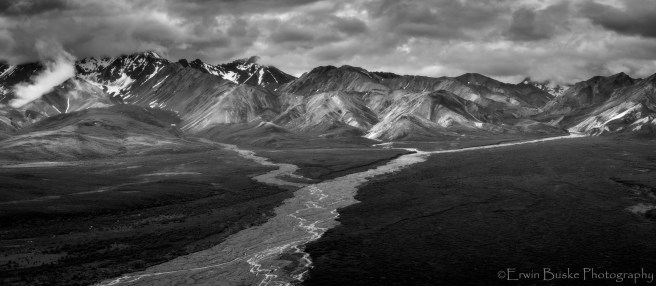
Denali Polychrome River Delta & in Monochrome (120 mm)
The Photographers Path
I have read through a large number of bios of landscape photographers (including my own) and there seems to be a common thread of what brought them to landscape photography that goes something like this. “Early on I started out my photographic journey with a desire to share the incredible beauty I was witnessing during my hikes, backpacks and adventures in the great out of doors. I purchased my first camera and started taking and sharing images. Although these images were not that good people reacted favorably to them which helped encourage me to develop my photographic skills which are still evolving to this day.” There is often little mention in these bios of any inward journey or even personal struggles that helped shape who the photographer is today.
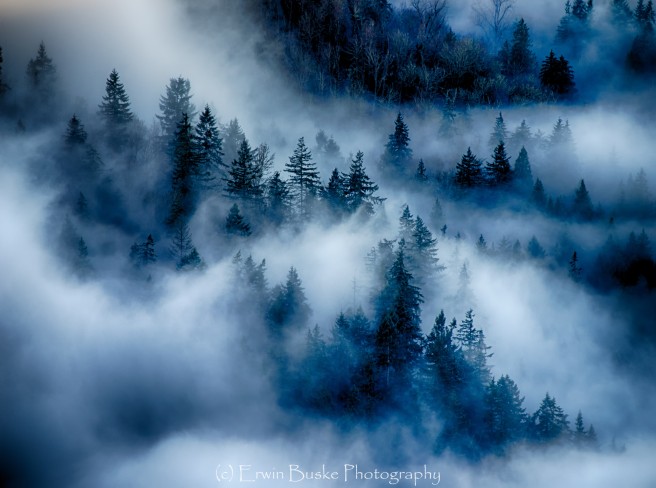
Secrets of the Forest (Poo Poo Point, but such a scene could at a forest anywhere 470 mm)
Conformity in Photography
Recently I have read numerous posts and essays from accomplished landscape photographers who are concerned that we are headed toward a visual conformity of images and styles in the field of landscape photography. These posts often place the blame on the social media and how it acts to influence the behavior of the photographer causing people to gravitate to the same iconic sites and compositions that seem to be popular on the internet. The antidote to all of this is typically to distance oneself from the influence of the social media, stop shooting iconic sites, start exploring out of the way previously undiscovered places, and to put down the expansive wide angle lens and take up different approaches to photography including abstracts, black and white, macros, etc.
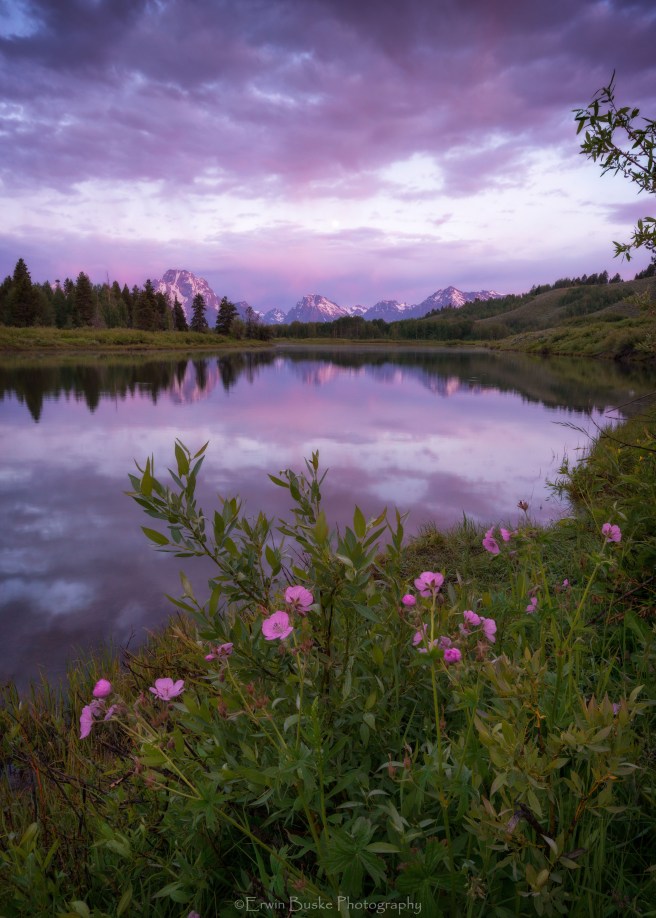
Wild Geranium Sunrise at Oxbow Bend (Iconic yes but I believe this is unique 23mm)
I struggle with this characterization of events that have led to the current conformity of visual content and styles in landscape photography and also the recommended steps to separate oneself from the herd. Finding ones photographic vision is intrinsically related to a lifelong journey of discovery of ones authentic self. If one is firmly planted on this inward journey one can faithfully deliver ones photographic vision at either an iconic site or at one known to no other. What makes one vision unique is not the physical location but the integration of one’s inward journey with the physical landscape. I am constantly amazed that just when I thought I have seen everything when it comes to an iconic landscape someone will come along with a very unique vision for that place. What I typically notice with such photographs is a tremendous sense of enthusiasm for the iconic site and a story where the photographer shares some of their inner journey, often emotionally based, that helped shape the image.
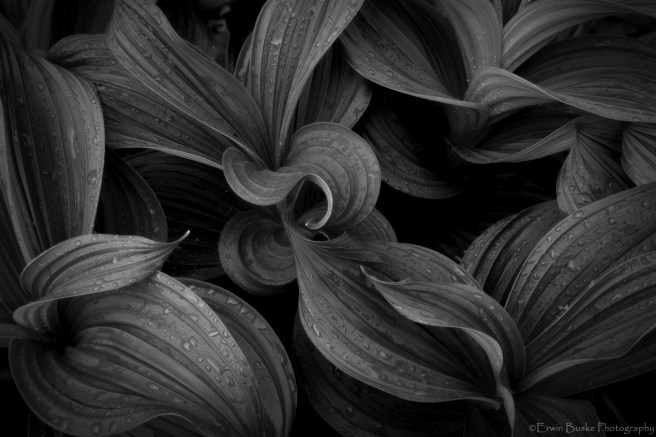
Spiral (35mm)
There is little doubt that changing ones shooting style, lets say trying black and white or macros, can help develop the photographers skill set and may even remove blocks in the way of bringing his/her vision to fruition. But these steps should not be mistaken for the vision itself. There are plenty of black and white images that lack vision just as there are hundreds of images of obscure and unknown places that slip into mediocrity. A transition to a different photographic style and shooting locations also makes sense as a marketing strategy to better differentiate ones product. But vision is ultimately connected with integration of ones inner landscape with the the outer landscape, not a particular kind of photography or location.
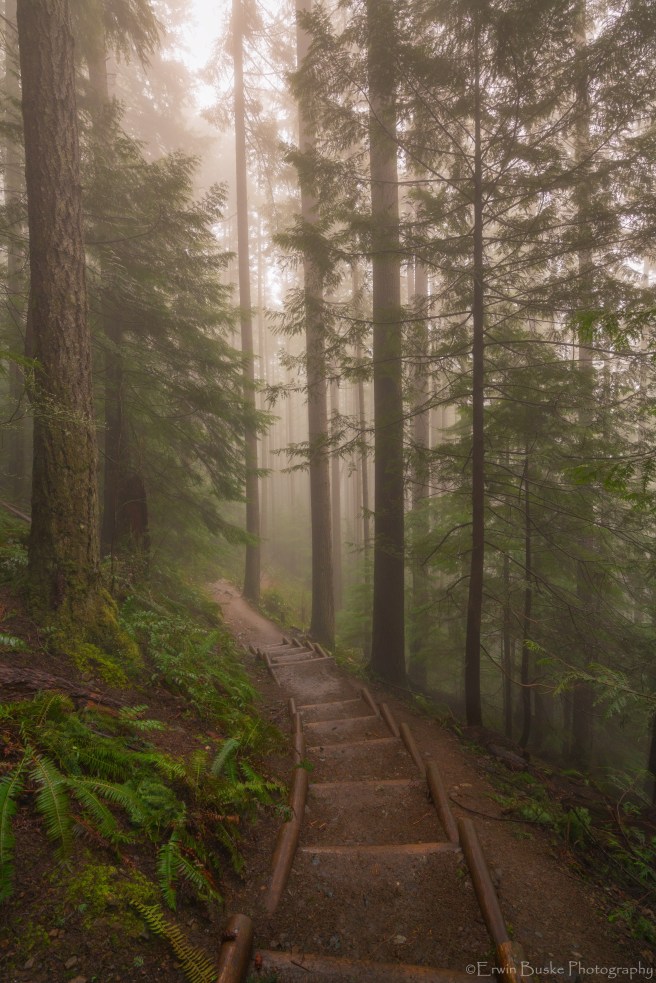
Foggy Trail (Mt. Si the most traveled trail in King County looking quite different! 16mm)
Social Media
To me social media has received a bad rap in all of this. If anything the social media is neutral and merely a reflection of the photographic community. There is no doubt that blindly chasing the social media in order to achieve greater popularity will cause people to gravitate to iconic sites, image cliches, excessive use of wide angle compositions, and eye candy sunrises and sunsets. But the social media itself is not responsible for this behavior. Each photographer must choose how to convey his/her photographic vision. It is not a personal vision if one is merely recreating compositions and processing methods of those who came before them.
I would go as far as to say that any photographer that has rose to popularity in the past five years and perhaps going back even as far as ten years owes his/her rise in no small measure to being discovered by the social media. With perhaps a few exceptions they would be all virtual unknowns if it were not for the ability of social media to bring them visibility. Even as the photographer gets discovered by the social media, many will then attempt to distance themselves from what brought them to fame and this is typically done in critical discussions of the social media on you guessed it the social media itself! It is understandable, however, that photographers would eventually take this step of limiting the effects of social media, sometimes even going into a social media celibacy. The path of discovering ones true creative potential, ones authentic self, may demand just this.

Prickly Pear Macro (105mm Macro)
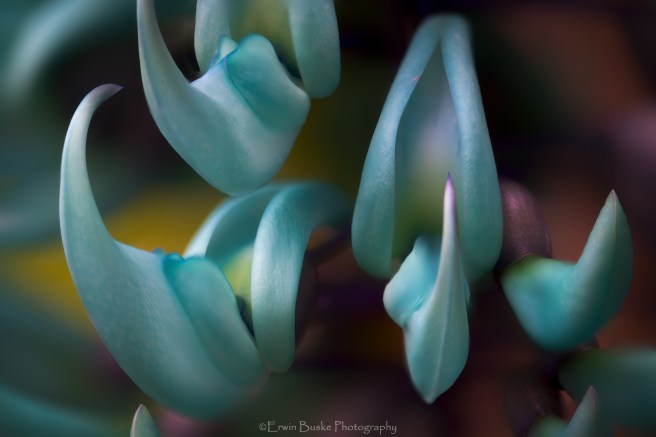
Jade Vine Abstract (105mm Macro)
The Authentic Self
That we can discover ourselves suggests that there is more to us than we know and we are mostly a mystery to ourselves. We do not know “all we are.” There is a movement in evolution of American history and culture called Transcendentalism that will help us in the understanding of the Authentic Self. Depth psychology pioneered by Carl Jung can also help us in understanding concepts that will shed some light on what it means to discover one’s Authentic Self.

Indian Beach Dreamtime Stepping Stones: Jung thought dreams provided important insight into the workings of the unconscious mind (19mm)
Transcendentalism
A core belief of transcendentalism is in the inherent goodness of people and nature. A common theme especially in the writings of Thoreau is going back to nature to find one’s self in other words finding ones own Waldon Pond! Adherents believe that society and its institutions have corrupted the purity of the individual, and they have faith that people are at their best when truly self reliant and independent. Key figures in the American transcendentalist movement include Ralph Waldo Emerson and Henry David Thoreau. Adherents believe that individuals are capable of generating completely original insights with as little attention and deference to past masters as possible. Transcendentalists have faith that people are at their best when truly “self-reliant” and independent. It is only from such real individuals that true community can form. Even with this necessary individuality, transcendentalists also believe that all people possess a piece of the Oversoul or (God). Because the Over-soul is one, this unites all people as one being.

Spirit of our Ancestors (A different view of iconic Spirit Falls) (16mm)
Now you are probably asking what has this to do with Landscape Photography? Finding ones self will involve becoming more self reliant and limiting the influence of others and the social media on ones own creative development. Finding ones self may also involve a more deliberate return to nature and meeting nature on its own terms without preconceived notions for an image.
“Be yourself; no base imitator of another, but your best self. There is something which you can do better than another. Listen to the inward voice and bravely obey that. Do the things at which you are great, not what you were never made for.”
—-Ralph Waldo Emerson, Self Reliance
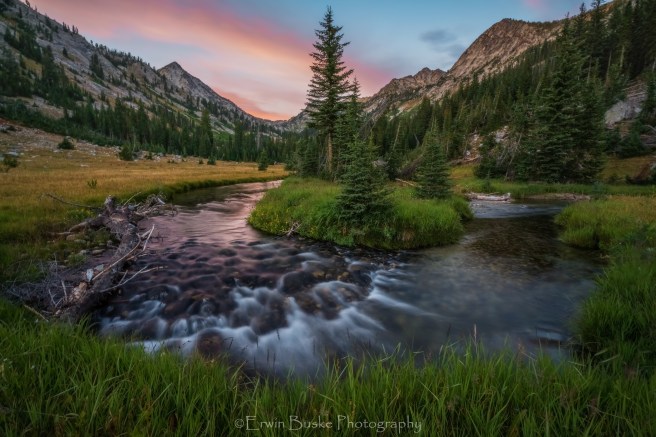
Rivers Bend Eagle Cap Wilderness (I have never seen this photographed before 16mm)
Depth Psychology and Carl Jung
The self in Jungian Psychology is an archtype signifying the unification of consciousness and unconsciousness in a person, and representing the psyche as a whole. The Self is realized as the product of individuation which in his view is the process of integrating one’s personality. Jung, like the Transcendentalists considered that from birth every individual has an original sense of wholeness – of the Self – but the development of a separate ego-consciousness diminishes the sense of Self. This process of ego-differentiation is necessary providing the skills one needs to make a living and survive in society and is the task of about the first half of one’s life-course, though Jungians also saw psychic health as depending on a periodic return to the sense of Self, something facilitated by the use of myths, initiation ceremonies, and rites of passage. The task for the second half of life (may be earlier for artists) has more to do with individuation and the integration of unconscious (personal and collective) and conscious elements in order to achieve the health of the pysche as a whole. This involves confronting ones own shadow or parts of one self that one does not want to acknowledge as one progresses to self knowledge.
Now again you are probably wondering even more what does this have to do with landscape photography? Finding ones vision in photography will require a lifelong path of self discovery and the road ahead will be difficult to follow and ultimately can be only followed by the self reliant individual alone. Just as new landscapes are discovered, the individual will discover previously hidden parts of him/herself that will set a new course for the journey. Great works of art are often created not so much with the completion of this journey but during the emotionally charged struggles along the way as one resists coming to terms with all elements of who one is as a person This is the journey of the artist and what Joseph Campbell referred to as the hero’s journey.
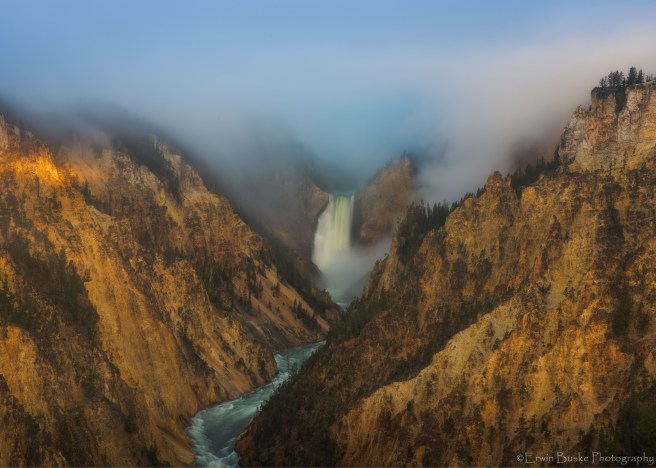
Misty Morning at Yellowstone Falls (Iconic yes but definitely a different mood! Iconic sites can have symbolic value in the collective consciousness 62mm)
Authentic Self Revisited
Finding ones authentic self for most of us is not a journey that will end anytime soon. Just when I think I know myself I will find out I do not know myself hardly at at all. And that is how it should be. It is a process of self discovery coinciding with our photographic journey. Ones emotions rising out of the process of self discovery will merge with and become part of ones feelings about the landscape and together find their way into the artists photographic creations. If you stay in tune to this struggle and journey it will shape your vision as photographer allowing you to distinguish yourself both shooting the iconic subject and your favorite haunts that no one else knows about but you!
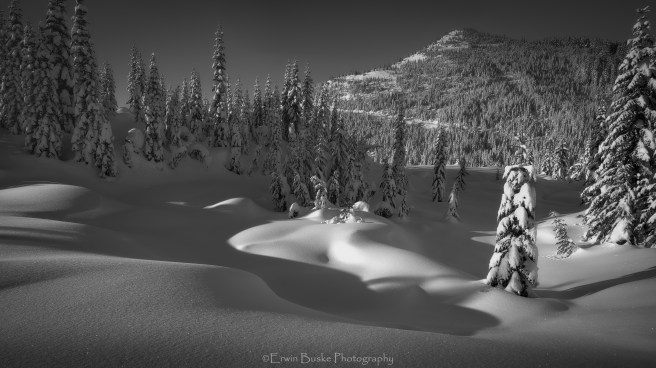
Sounds of Silence (A seldom photographed spot along the Kendal Snowshoe Trail 18mm)
Erwin Buske Photography (c) 2017
Thanks for reading this blog post. Your comments, concerns, and perspectives on this issue are all welcome! If you like this post and want to see future posts please subscribe to the blog. Thanks again!

Interesting post and fantastic images to illustrate your ideas, Erwin. Much to think about. Thanks.
LikeLiked by 1 person
Thanks Jane, good to hear from you! I appreciate your feedback greatly!
LikeLiked by 1 person
Great post Erwin, wonderful images.
LikeLike
Thanks Karen, I am glad you enjoyed the post and images!
LikeLiked by 1 person
Amazing Images! Sage advice😊
LikeLiked by 1 person
Thanks Leanne, I appreciate your comment greatly!
LikeLike
Interesting article Erwin. A while ago, I came to a cross roads. I had to decide who I made images for – for the ever illusive media machine, or for myself. Ultimately, I chose to make images that made me feel happy and fulfilled. I always hope that others will likewise enjoy my efforts, and often they do, but the pressure of seeking social media approval is no longer paramount – at least on a good day! 😉 That sounds selfish, but I believe that, for me, making images that please me is at the heart of discovering my own identity as a photographer.
PS I thoroughly enjoyed your images and envy your access to such beautiful scenery.
LikeLiked by 2 people
Thanks Betty! You hit upon one of the central points of the blog post from the perspective of your personal experience. I firmly believe that if you follow the voice of your own self that you are best postured to tap into your creative potential. When you share images that reflect your sense of self others will detect something truly creative and unique that also, however, resonates with their own experience as a person. Finding the self is the path to experiencing something that is also greater than anyone person, a sense of the spiritual that unites us all.
LikeLike
Awesome thoughts Erwin. I enjoyed the read. Thank you for writing this. Your first sentence for me says a lot. We are always searching… Happy trails, Kevin
LikeLiked by 1 person
Thanks so much Kevin for stopping by and reading this and providing some feedback -greatly appreciated!
LikeLike
Inspirig article. Thanks for taking the time to write it and publish.
I am just starting out in photography, and it is helpful to read this.
Greg
LikeLike
Thanks Greg-I wish you success on your photographic journey and I am happy this blog post provided you some guidance along your way!
LikeLike
I see you don’t monetize photo.blog, don’t waste
your traffic, you can earn additional cash every month
with new monetization method. This is the best adsense alternative for any type of website (they approve all sites), for more info simply search in gooogle: murgrabia’s tools
LikeLike